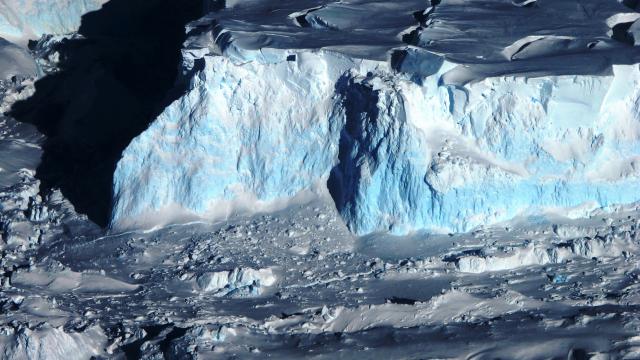Everyday it feels like science fiction and reality slide ever closer together. In the latest edition of “could this happen,” scientists have published a new study that weighs building massive berms to protect receding Antarctic glaciers.
The results focus on one of the most at-risk glaciers ringing Antarctica, and show that we could indeed save it with a big enough berm. Now, we just need to figure out how to build the berms, if we can save other glaciers, who decides if this is a good idea, who pays for it, and if it’s worth the cost. No big deal.
Geoengineering is a grab bag of technological climate mitigation strategies that tend to be controversial, in part because they could wildly screw up the planet. The most often-discussed idea involves hacking the whole planet by shielding it from the sun, which would cool things down while humanity gets its shit together when it comes to carbon pollution. But while that idea could really mess up rainfall patterns and have a host of other adverse consequences, hacking the Antarctic is a bit different.
This more targeted geoengineering strategy would affect only glaciers, which the new study’s author Michael Wolovick called “very high-leverage points.” This isn’t to say it’s a perfect plan, but it is an intriguing concept in a rapidly expanding suite of proposals on how to slow down climate change.
The study, published on Thursday in the Cryosphere, looks at how we could protect Thwaites Glacier from runaway melt. That glacier is part of the West Antarctic area that’s in serious trouble due to warm water undercutting the ice shelves that extend out over the sea. The bedrock in this area slopes downward as it moves inland, meaning the front face of the glacier is growing ever taller, increasing the risk of instability.
The region may already be in a phase of unstoppable melt that could result in many metres of sea level rise.
“The societal consequences of rapid sea level rise are enormous,” Wolovick, a researcher Princeton, told Gizmodo in an email. “Even a meter of rise would require society to spend tens of billions of dollars per year shoring up coastal defences like dikes, levees, etc… Yet a meter of sea level rise is relatively small compared to what the ice sheets are capable of.”
In the face of this meltdown, a group of scientists that include Wolovick have previously proposed building huge underwater berms to help prop up glaciers and cut off the flow of warm water. That could allow them time to grow back and toughen up. The new analysis looks at what the success rate of stabilising the ice would be under different types of protection.
In one scenario, they looked at “isolated pinning points,” which wouldn’t block any of the warm water but would help give the glacier something to hang onto while in the other scenarios, they looked at small berms that blocked half and all of the water as well as a very tall berm to block it all further from the glacier itself.
Perhaps not surprising, the last iteration was most effective according to their model simulations, preserving the glacier 100 per cent of the time. But even the isolated berms were still effective in 30 per cent of their model runs under a roughly business-as-usual warming scenario. And those berms are within reach of current human capabilities. The study points to China’s South — North Water Transfer Project as requiring a similar amount of excavation.
The bigger berms are an order of magnitude outside our current capabilities, but that doesn’t mean they’ll always be infeasible. The paper suggests we could start trying to do this with smaller glaciers and scale up from there.
“The specific designs that we looked at are nowhere near being ready for implementation, and we are not advocating that glacial geoengineering begin any time soon,” Wolovick said. “What we are advocating instead is the beginning of a process of iterative design improvement.”
“While this project still borders on the side of fantasy, someday it may be our only alternative reality,” Andrea Dutton, a geologist at the University of Florida, told Gizmodo. “It will be a lot easier to cut emissions than to do this — we have the technology in place and know what we need to do. At the end of the day treating only the symptoms rather than the cause is not an effective way forward.”
The allure of a project like this to the millions of people living on the coast is clear, particularly in low lying islands that could become uninhabitable by mid-century. But it also opens up a huge can of worms.
There’s currently no form of global governance for this type of geoengineering project. It opens up questions of equity. Do we spend our money doing this to protect the coasts while the West burns to a crisp or the Sahel region of Africa gets consumed by the Sahara? How do we decide which glaciers — which each contribute different amounts local sea level rise owing to weird planetary physics — to modify first once we work out the kinks? Should it be ones that save those most in need, or those with the most money to fund the project? Where the hell is the money going to come from anyways? (The researchers give the side eye to the US military budget, which fair.)
Further research and discussion is essential to answer those questions. We’re running out of time to cut emissions and stave off the worst impacts of climate change, making geoengineering more likely. But we need to know at what cost.
